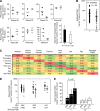FADD protein release mirrors the development and aggressiveness of human non-small cell lung cancer
- PMID: 22669160
- PMCID: PMC3388563
- DOI: 10.1038/bjc.2012.196
FADD protein release mirrors the development and aggressiveness of human non-small cell lung cancer
Abstract
Background: The need to unfold the underlying mechanisms of lung cancer aggressiveness, the deadliest cancer in the world, is of prime importance. Because Fas-associated death domain protein (FADD) is the key adaptor molecule transmitting the apoptotic signal delivered by death receptors, we studied the presence and correlation of intra- and extracellular FADD protein with development and aggressiveness of non-small cell lung cancer (NSCLC).
Methods: Fifty NSCLC patients were enrolled in this prospective study. Intracellular FADD was detected in patients' tissue by immunohistochemistry. Tumours and distant non-tumoural lung biopsies were cultured through trans-well membrane in order to analyse extracellular FADD. Correlation between different clinical/histological parameters with level/localisation of FADD protein has been investigated.
Results: Fas-associated death domain protein could be specifically downregulated in tumoural cells and FADD loss correlated with the presence of extracellular FADD. Indeed, human NSCLC released FADD protein, and tumoural samples released significantly more FADD than non-tumoural (NT) tissue (P=0.000003). The release of FADD by both tumoural and NT tissue increased significantly with the cancer stage, and was correlated with both early and late steps of the metastasis process.
Conclusion: The release of FADD by human NSCLC could be a new marker of poor prognosis as it correlates positively with both tumour progression and aggressiveness.
Conflict of interest statement
The authors declare no conflict of interest.
Figures




References
-
- Alifano M, Cusumano G, Strano S, Magdeleinat P, Bobbio A, Giraud F, Lebeau B, Regnard JF (2009) Lobectomy with pulmonary artery resection: morbidity, mortality, and long-term survival. J Thorac Cardiovasc Surg 137(6): 1400–1405 - PubMed
-
- Balachandran S, Thomas E, Barber GN (2004) A FADD-dependent innate immune mechanism in mammalian cells. Nature 432(7015): 401–405 - PubMed
-
- Beisner DR, Chu IH, Arechiga AF, Hedrick SM, Walsh CM (2003) The requirements for Fas-associated death domain signaling in mature T cell activation and survival. J Immunol 171(1): 247–256 - PubMed
-
- Bhojani MS, Chen G, Ross BD, Beer DG, Rehemtulla A (2005) Nuclear localized phosphorylated FADD induces cell proliferation and is associated with aggressive lung cancer. Cell Cycle 4(11): 1478–1481 - PubMed
Publication types
MeSH terms
Substances
LinkOut - more resources
Full Text Sources
Other Literature Sources
Medical
Research Materials
Miscellaneous

